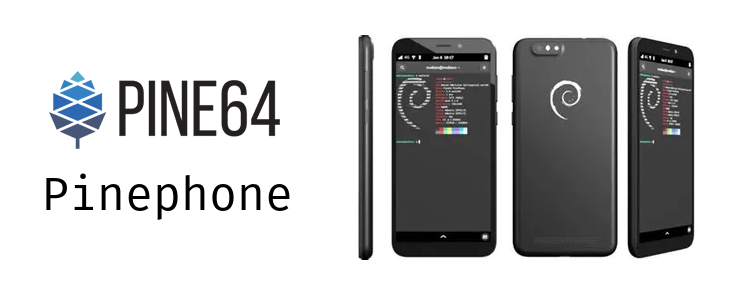Pinephone is where I think personal tech should be headed. But we’re not talking about that here. This is going to be me nerding out and showing off this tinkerer’s dream of a phone.
Pinephone by PINE64
The hardware is really not that impressive from a performance point of view. The mali GPU is quite dated and the camera’s really only function as little more than proofs of concept. You get bluetooth, wifi (2.4GHz only), a cellular modem and antenna. There’s a touch screen, an audio jack, a USB-C port, and power and volume buttons. All that is pretty standard on any phone.
Special Hardware Features
The modem on this phone is special for two reasons. Firstly it’s only connected to the main system via USB unlike many other phones which connect the modem to the main system memory bus. This provides some segregation which may help improve security. The more important reason the modem is special is because you can flash custom firmware to it using a utility called fwupd. Some distros make this process really easy. There’s an almost entirely open source firmware implementation out there which dramatically improves battery life. Just another benefit of open systems. It’s also a big plus for those of us who are concerned about privacy issues.
A major feature from a use-case stand point is the pinephone’s convergence capabilities. If you connect a monitor and peripherals to the pinephone via the USB-C dock, it functions like a regular linux desktop. Mobile and desktop converge on a single device. Software interfaces like Gnome are making a lot of progress in making this a smooth experience. More and more apps are being implemented to be “responsive” meaning they’ll play nice with a touch interface and the phone’s portrait aspect ratio.
The pinephone has a removable battery and expandable storage. You can also augment the on-board storage with a micro-SD card. Mine is 128GB. The battery has the classic Samsung form-factor which you can buy online. Easily replaceable batteries are rare in phones now.
The pogo pins on the back of the phone allow custom hardware to be connected to the phone in the form of alternative backcovers. For instance I own a backcover that enables the pinephone to wirelessly charge and another backcover which has a LoRa antenna to increase the phone’s radio capabilities.
Pinephone has dip switches under the backcover to cut power to individual components should you so choose. This is often considered a security feature. I don’t use them, but it is a pretty unique hardware feature. There are switches for the cameras, the bluetooth/wifi module, the baseband modem, and the microphone respectively.
Operating System
The main thing that sets this phone apart form the rest is the software stack. This is a Linux first device meaning it was designed from the beginning with the intention of running a true Linux distro on it not unlike the Raspbian OS on Raspberry Pis.
I’m looking to switch from mobian to postmarketOS. My sense is that an alpine based distribution is more appropriate in the mobile space given the smaller size. Debian is good for servers and reliable workstations. The thing that’s holding me back is that the signal desktop app does not officially support arm64 machines. But there is an unofficial deb package for arm64 which I use. I would need a similar build for postmarket. I could use signal through a matrix bridge but that would mean losing encrypted voice calls. It’s simpler to stick with mobian for now.
Interface
I use Phosh by Purism because I’m partial to the Gnome way of doing UI over KDE. I think a more opinionated DE makes more sense. I like the feeling of convergence between desktop and mobile although I’m not a fan of using JS for extensions. Various efforts toward adaptive interfaces throughout Gnome projects give me the sense that one day soon regular Gnome may work out of the box on mobile. Until then, we’re sticking with Phosh.

Applications
I’ll be updating this section with whatever I’m currently running, seeing as the pinephone space is rapidly changing. As of May 2023:
I have switched to the PinphonePro after breaking the SIM card pins on my original Pinephone. Pretty much everything above still applies. The PinephonePro simply has a more powerful processor and better camera sensors.
| Function | App | Comment |
|---|---|---|
| Matrix Messaging | Chatty | Also does SMS/MMS. It’s nice to have all that in one place. |
| Signal Messaging | Signal Desktop | I’m using the unofficial arm64 build for debian. Not well optimized for touch but I get by. |
| Jami Messaging | Jami | The UI scales well enough. |
| Navigation | Pure Maps | Needs OSM Scout Server. Unreliable turn by turn navigation. And limited POI. |
| Music | Amberol | Support for m3u or similar playlist files would make it perfect. |
| Mousai | Identifies songs. | |
| Browser | Firefox ESR | They’ve optimized this quite well. |
| File Browser | Files (Nautilus) | Another adaptive Gnome app. Still not quite polished but better than Portfolio IMO. |
| Calendar | Gnome Calendar | The new adaptive interface is very nice. |
| Contacts | Gnome Contacts | CarDAV through Gnome’s nextcloud integration. |
| Camera | Camera | Takes pictures. Sort of takes video. Needs optimization. |
| Translation | Dialect | Uses Google translate under the hood. |
| File Sync | Syncthing | Works well enough to keep my music synced to my laptop. |
Some other good apps I’ve tried:
| Function | App | Comment |
|---|---|---|
| TOTP 2FA | Authenticator | Just works. |
| Ebooks | Foliate | Just a great app. |
| Matrix | Fluffychat | GTK based and implements encryption. |
